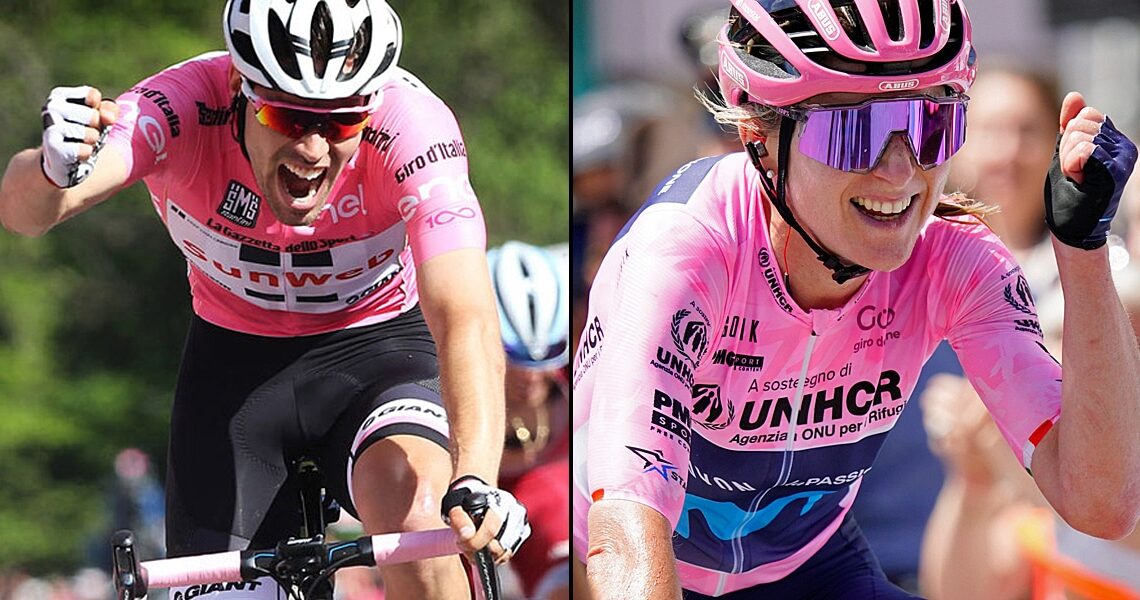What can we learn from breaking down physical race data captured at the Giro d’Italia for both men and women? Anna van Vleuten and Tom Dumoulin agreed to supply personal data for a unique study into the comparison of the demands of grand tour racing on male and female athletes.
Annemiek van Vleuten won the Tour de France 2022
One of the best things in cycling over the past decade has been the increasing opportunities and professionalism in women’s cycling. This includes more professional teams that are both bigger in scope and better funded, through to expansion of the racing calendar and more media coverage and live television. Of course, after tentative steps by the ASO with the one-day La Course, the biggest splash of all came with the introduction of the 8-stage Tour de France Femmes in 2022.
The change has been such that being a pro cyclist is now a viable full-time career for some female cyclists, and this has also led to an improvement of performance due to being able to devote all of one’s energies to training and racing. This has led to increasing interest in studying the unique nature and demands of female training and racing, much of it led by my friends Rob Lamberts from South Africa and Teun van Erp from the Netherlands.
Especially with more stage racing for women, one new entry into this scientific literature is a comparison of the relative physiological demands of stage racing demands between men and women. Lamberts’ study is called “Racing Demands for Winning a Grand Tour: Differences and Similarities Between a Female and a Male Winner”, and I wanted a closer look at this first-of-its-kind research.
Specifically, Annemiek van Vleuten and Tom Dumoulin collaborated with Lamberts and van Erp by sharing their full data from racing the 10-stage 2018 and 2019 Giro Rosa (van Vleuten won both) and the 21-stage 2017 and 2018 Giro d’Italia (Dumoulin won in 2017 and was second in 2018) (Lamberts et al. 2024).
A few clear statements from me before we dive into the data:
This study (and my analysis) is most definitely NOT to debate whether women’s or men’s racing is harder/better. They are both unique and entertaining.
The Giro Rosa may now be overshadowed by the prestige of Le Tour Femmes, but it was the preeminent stage race of the entire season during this time frame, so it provides an excellent insight into the top female cyclist at the top event of her year.
Normally scientific studies don’t disclose the identities of their participants. However, van Vleuten and Dumoulin are co-authors in this study, plus the description of the two participants’ racing history makes it impossible to maintain confidentiality.
Grand Tour Demands
Table 1 from the paper lays out the basic demands of both races.
One obvious difference is the greater number of stages and the longer stage duration for men, with essentially doubling of both for men. However, the shorter stages can lead to a lot more aggressive racing. For example:
Van Vleuten’s absolute work done above Critical Power (i.e., very high intensity and non-sustainable efforts) were similar to Dumoulin’s. Indeed, while not statistically significant, van Vleuten spent more time above CP.
Van Vleuten experiences higher physiological strain (TSS) per kilometre raced than Dumoulin.
Did Demands Alter Based on Stage Type?
The study further broke down analysis into different stage types: Time Trial (TT), FLAT, semi mountain stages (SMT), and high mountain stages (MT). Looking at this analysis, the big difference in TSS/Km came down to the TT, with the other stage types having similar demands.
However, van Vleuten spent a lot more proportion of time above CP in flat, SMT, and HT stages. One possible explanation beyond more aggressive racing is that she had a lot less team support, as her domestique may not have been able to shield her from the wind as much or as deep into a stage, forcing her to do more work. This is supported by an analysis where, on FLAT stages, van Vleuten rode at a much higher percentage of her FTP in the first half of the stage than Dumoulin. In the final quarter of mountain stages, van Vleuten also rode at a higher percentage of her FTP than Dumoulin.
Another difference between van Vleuten and Dumoulin was that, aside from TTs, the demands of FLAT, SMT, and MT stages differed quite markedly for Dumoulin, but were fairly similar for van Vleuten. Many reasons may be at play here. For example, it could be that the shorter stages for females just made all stages similarly challenging. It could also be because of different course, team, or race dynamics.
Van Vleuten – Giro Donne winner 2022
Durability in Cyclists
The concept of durability, or whether a rider can still ride hard at the end of a stage after already expending a lot of energy, is what often separates the race winner from their competitors. In this analysis, both van Vleuten and Dumoulin were world-class (fairly obvious due to their victories in these Giri). Van Vleuten only saw reductions of mean maximal power after burning 30 kJ/kg (75% of total kJ burnt), while Dumoulin only saw decreases at 45 kJ/kg (80% of total kJ burnt). No prior analysis has been done on female cyclists, but analyses on professional male cyclists – even successful climbers – often started seeing declines after 20-25 kJ/kg burnt.
Practical Applications
Besides a gee-whiz look into what it takes to ride and win a Grand Tour, analyses such as these help in developing and training future champions. Optimizing training requires knowing the targets or numbers that you need to hit in order to succeed, and that is something that we can take away for our own cycling.
If you race the same race multiple years and know that you always get dropped on the big hill of the circuit, you can use your own power numbers as a benchmark, then use tools like Strava segments to see how fast your competitors climbed that hill or what their power numbers were as your target for training.
The other highlight of the study is the tremendous durability of both van Vleuten and Dumoulin. The whole point of racing, short of maybe a track sprint, is to separate riders by first putting them under fatigue. That can be done by very long stages like in professional males, or by shorter but maybe more intense stages like in professional females. For us, whether in road racing or in long gravel races, the key to performance is being able to push when everyone else is getting tired.
Ride fast, and have fun!
References
Lamberts RP, Vleuten A van, Dumoulin T, et al (2024) Racing Demands for Winning a Grand Tour: Differences and Similarities Between a Female and a Male Winner. International Journal of Sports Physiology and Performance 19:1209–1217. https://doi.org/10.1123/ijspp.2023-0476
Tom Dumoulin in pink 2019
The post Physical Demands of the Giro d’Italia in Men Vs Women appeared first on PezCycling News.




